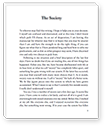Essay Instructions: Critical Response
Read the newspaper editorial. write an essay analyzing the major strengths and
weaknesses of the editorial, giving specific examples from the article.
TIPS ON ORGANIZING THE CRITICAL RESPONSE:
Introduction
Your critical response will normally begin with a paragraph that introduces the work under
discussion and presents your thesis statement. That thesis statement should express your opinion
about the article’s strengths and weaknesses, not about the subject matter itself. Students
sometimes have difficulty wording their thesis to include something both positive and negative;
Thinking it Through’s discussion of complex thesis statements on pages 27-28 is helpful here.
For example, you might begin your thesis with a word like “Although” (“Although the writer
does A and B well, his argument is weakened by C and D” or “In spite of a serious problem with
E, her article’s strong F and G make it convincing”). This type of thesis allows you to
acknowledge both strong and weak points and clearly indicates the order of points in the essay
body.
General Content Information
Following the introduction, give your readers a brief overview of the work’s contents: for
example, its topic, its central argument, and the main points used to support that argument. This
section does not need to be long – a paragraph will do for an essay of this length – but you do
need to demonstrate that you have read and understood the piece.
Evaluation and Analysis
Here in the main body of the essay, which will probably comprise several paragraphs, you will
present your critical response to the work. Attempt to structure your paragraphs according to the
point you wish to make in each – not according to the order of the article. (See pages 18-19 of
A Writer’s Handbook for assistance with paragraph structure.) Your paragraphs’ topic sentences
should make points which you can support with evidence and examples; they should not just
summarize. If you find your topic sentences saying things like “Then the author moves on to his
next topic” (which is not a point that you can support with evidence), you may be doing more
describing than analyzing.
Note also, when developing your points, that not all of the persuasive strategies, reasoning
errors, etc. discussed in Thinking it Through will apply to the article you are analyzing. Do not
treat this assignment as a checklist that touches on every single point the textbook refers to.
Instead, choose those points – three or four, perhaps – which you consider most relevant to your
critique of the article, and develop your thesis and body paragraphs around those points.
Finally, keep in mind that the editorial you are analyzing is not itself an academic essay and
therefore cannot be judged as one. You will get off track if you try to evaluate the article for
features like a thesis statement and topic sentences, which characterize an academic essay but
not necessarily a journalistic piece. Focus instead on your purpose: to evaluate the strengths and
weaknesses of the writer’s argument based on your reading of Thinking it Through.
(Continued on following page)
19
Conclusion
Do not simply repeat the points made earlier in the essay, but make some comment about the
article’s overall significance, value, or effectiveness. (Pages 146-7 of Thinking it Through and
25-26 of A Writer’s Handbook have helpful information on writing conclusions.) Above all, be
sure that the conclusion accurately reflects what you have actually argued in the body of the
essay. If you have been very negative about the editorial in the essay body but then decide when
writing your conclusion that the piece is not so bad after all, your reader may wonder which is
your actual opinion.
Notes on Referencing
As stated in the section “Documentation, Plagiarism and Academic Dishonesty” in the front of
these course notes, you are required to use the MLA documentation format (described in detail
on pages 153-173 of The Little, Brown Handbook) for all WRIT 075 essays. For this
assignment, the only book you might be referring to is Thinking it Through; such references
should be followed by the author’s name and the page number in parentheses. For example:
Non-sequitur is “a catch-all phrase for the most obvious errors in logical reasoning”
(Boyne et al. 70).
Your newspaper editorial does not have page numbers; therefore, references to it should be
followed by paragraph numbers. For example:
The author’s mistaken reference to “the Kyoto exchange” (par. 3) is shocking.
(end of Assignment Four
Nations can thrive without democracy, but only for so long.
MARCUS GEE
More than stunning architecture, organizational
skill and economic progress will be on display
when Beijing hosts the Olympic Games. What
the world will see is a living demonstration of
the argument that nations can thrive without
democracy.
China in the early 21st century has become
both a powerful example, and a leading
exponent, of that notion. Without a whiff of
real democracy, it has leapt from isolated,
impoverished state to economic dynamo and
emerging global power. Its success challenges
some of the central assumptions that have
governed international affairs since the end of
the Cold War.
After the triumph of Western capitalist
democracies in the decades-long standoff with
world communism, it was expected that liberal
democracy would become the worldwide norm.
As countries such as China and Russia
embraced global trade and open markets, and
as their growing middle classes called for a
greater say in how they were governed, they
would inevitably evolve into Western-style
electoral democracies. "At the end of history,"
American thinker Francis Fukuyama put it in a
renowned essay, "there are no serious
ideological competitors left to liberal
democracy."
The brilliant success of China under
undemocratic rule may have buried that
optimistic idea. American columnist Robert
Kagan, author of a new book, The Return of
History and the End of Dreams, says
"autocracy is making a comeback." Russia's
drift back into authoritarianism under Vladimir
Putin means "two of the world's largest nations,
with more than a billion and a half people and
the second- and third-largest militaries between
them, now have governments committed to
autocratic rule and may be able to sustain
themselves in power for the foreseeable future."
The leaders of these regimes are not just venal
power-mongers clinging to office against the
popular will, Mr. Kagan writes. "They believe
in autocracy ... By providing order, by
producing economic success, by holding their
nations together and leading them to a position
of international influence, respectability and
power, they believe that they are serving their
people."
Many Chinese and Russians seem to agree.
China's leaders face no real challenge to their
rule and Mr. Putin remains far more popular
than many democratic leaders could dream of,
despite his steady accumulation of unchecked
power.
The success of capitalist autocracy (or market
Leninism, if you like) is sobering to those of us
who have argued for years that economic
progress would lead to democratic progress in
the developing world. It is a reminder that
ordinary people put a premium on order,
especially if they are from countries like Russia
and China that have suffered through the lack of
it. If an undemocratic regime can offer them
stability in their lives and money in their
pockets, it's no wonder they don't quibble about
their lack of rights or votes.
The trouble is you can't have lasting order
without democracy. Mr. Kagan argues that with
a combination of competence and ruthlessness,
China's leaders can probably keep China orderly
and its economy growing for years to come.
Perhaps.
But the good times for China and Russia can't
go on forever. Russia's current prosperity floats
on high oil prices, which are even now showing
signs of coming back to earth. The Chinese
regime's claim to economic success rests on a
distorted, export-driven economic model that
may come undone rather suddenly. Inflation,
the doom of many an autocrat, is already
rearing its head.
Even if growth continues to soar, pressure for
democratic reform could rise as the middle
classes start to feel their oats. The American
China scholar Bruce Gilley notes that the
middle classes of South Korea, Taiwan and the
Philippines were co-opted and quiescent right
until the brink of the democratic transition.
Despite all its progress, China is still at roughly
the same level of economic development as
Angola or Azerbaijan, short of the stage where
democratic aspirations tend to bloom.
Maybe it was naive to expect liberal democracy
to spread naturally around the world like a
garden vine after the Cold War ended. It would
be equally naive to think that the capitalist
autocrats of Moscow and Beijing have invented
a formula for governing forever without the
nuisance of elections. Some day soon, their
people will want something better, and in time
they will get it.
The Globe and Mail
Friday, July 25, 2008


